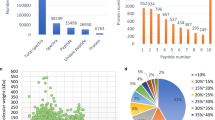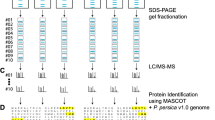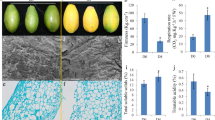Abstract
To explore the relationship between fruit developmental periods and the protein datasets of Alpinia oxyphylla, a label-free quantitative proteomic profiling analysis of the A. oxyphylla fruits sampled at the Earlystage, Metaphase and Advanced stage was carried out using the liquid chromatography combined with tandem mass spectrometry. A total of 19,219 peptide fragments and 4946 quantitative proteins were obtained. Annotation and enrichment analysis of these peptides and proteins were performed using the Gene Ontology (GO) and the Kyoto Encyclopedia of Genes and Genomes (KEGG) databases with bioinformatics software. The results showed that the differentially expressed proteins were mainly involved in metabolic and cellular processes, cellular component organization or biogenesis and response to the stimulus. Three significantly enriched metabolic pathways were non-alcoholic fatty liver disease, vibrio cholera infection and valine, leucine and isoleucine degradation. The significantly enriched proteins were NADH dehydrogenase, putative vacuolar proton translocation ATPase and putative acyltransferase component. The proteomic profiles of the fruit samples from the Advanced and the Metaphase stages differed little, while the difference in proteomic components between the Earlystage and the Advanced groups was significant. This study should lay the theoretical foundation for the effective utilization of A. oxyphylla germplasm resource in the treatment of human diseases.








Similar content being viewed by others
Change history
06 August 2020
The original article can be found online.
References
An LJ, Guan S, Shi GF, Bao YM, Duan YL, Jiang B (2006) Protocatechuic acid from Alpinia oxyphylla against MPP+-induced neurotoxicity in PC12 cells. Food Chem Toxicol 44(3):436–443
Ashburner M, Ball CA, Blake JA et al (2000) Gene ontology: tool for the unification of biology. The Gene Ontology Consortium. Nat Genet 25(5):25–29
Batelli S, Peverelli E, Rodilossi S, Forloni G, Albani D (2011) Macroautophagy and the proteasome are differently involved in the degradation of alpha-synuclein wild type and mutated A30P in an in vitro inducible model (PC12/TetOn). Neuroscience 195:128–137
Bian QY, Wang SY, Xu LJ, Chan CO, Mok DKW, Chen SB (2013) Two new antioxidant diarylheptanoids from the fruits of Alpinia oxyphylla. J Asian Nat Prod Res 15(10):1094–1099
Calder PC (2006) Branched-chain amino acids and immunity. J Nutr 136(1):288S–293S
Chang YM, Velmurugan BK, Kuo WW, Chen YS, Ho TJ, Tsai CT, Ye CX, Tsai CH, Tsai FJ, Huang CY (2013) Inhibitory effect of alpinate Oxyphyllae fructus extracts on Ang II-induced cardiac pathological remodeling-related pathways in H9c2 cardiomyoblast cells. Biomed 3:148-152
Chang YM, Chang HH, Tsai CC, Lin HJ, Ho TJ, Ye CX, Chiu PL, Chen YS, Chen RJ, Huang CY, Lin CC (2017) Alpinia oxyphylla Miq. Fruit extract activates IGFR-PI3K/Akt signaling to induce Schwann cell proliferation and sciatic nerve regeneration. BMC Complem Altern M 17(1):84
Chapman MA (2014) Interactions between cell adhesion and the synaptic vesicle cycle in Parkinson’s disease. Med Hypotheses 83(2):203–207
Chen F, Li HL, Tan YF, Guan WW, Zhang JQ, Li YH, Zhao YS, Qin ZM (2014) Different accumulation profiles of multiple components between pericarp and seed of Alpinia oxyphylla capsular fruit as determined by UFLC-MS/MS. Molecules 19:4510–4523
Cox J, Mann M (2008) MaxQuant enables high peptide identification rates, individualized p.p.b. range mass accuracies and proteome-wide protein quantification. Nat Biotechnol 26(12):1367–1372
Cox J, Neuhauser N, Michalski A, Scheltema RA, Olsen JV, Mann M (2011) Andromeda: a peptide search engine integrated into the MaxQuant environment. J Proteome Res 10(4):1794–1805
Cox J, Hein MY, Luber CA, Paron I, Nagaraj N, Mann M (2014) Accurate proteome-wide label-free quantification by delayed normalization and maximal peptide ratio extraction, termed MaxLFQ. Mol Cell Proteomics 13(9):2513–2526
Dixon RA, Lamb CJ, Masoud S, Sewalt VJH, Paiva NL (1996) Metabolic engineering: prospects for crop improvement through the genetic manipulation of phenylpropanoid biosynthesis and defense responses-a review. Gene 179(1):61–71
Dixon RA, Achnine L, Kota P, Liu CJ, Reddy MSS, Wang LJ (2002) The phenylpropanoid pathway and plant defense-a genomics perspective. Mol Plant Pathol 3(5):371–390
Ebrahimi-Fakhari D, Cantuti-Castelvetri I, Fan Z, Rockenstein E, Masliah E, Hyman BT, McLean P, Unni VK (2011) Distinct roles in vivo for the ubiquitin-proteasome system and the autophagy-lysosomal pathway in the degradation of alpha-synuclein. J Neurosci 31:14508–14520
Esposito G, Clara FA, Verstreken P (2011) Synaptic vesicle trafficking and Parkinson’s disease. Dev Neurobiol 72(1):134–144
Fang JY, Leu YL, Hwang TL, Cheng HC, Hung CF (2003) Development of sesquiterpenes from Alpinia oxyphylla as novel skin permeation enhancers. Eur J Pharm Sci 19:253–262
Gao B, Yuan L, Tang T, Hou J, Pan K, Wei N (2019) The complete chloroplast genome sequence of Alpinia oxyphylla Miq. and comparison analysis within the Zingiberaceae family. PLoS ONE 14(6):e0218817
Götz S, García-Gómez JM, Terol J, Williams TD, Nagaraj SH, Nueda MJ, Robles M, Talón M, Dopazo J, Conesa A (2008) High-throughput functional annotation and data mining with the Blast2GO suite. Nucleic Acids Res 36(10):3420–3435
He ZH, Ge W, Yue GGL, Lau CBS, He MF, But PPH (2010) Anti-angiogenic effects of the fruit of Alpinia oxyphylla. J Ethnopharmaco 132:443–449
Hou L, Ding G, Guo BL, Huang WH, Zhang XJ, Sun ZY, Shi XF (2015) New sesquiterpenoids and a diterpenoid from Alpinia oxyphylla. Molecules 20:1551–1559
Jiang B, Wang WJ, Li MP, Huang XJ, Huang F, Gao H, Sun PH, He MF, Jiang ZJ, Zhang XQ, Ye WC (2013) New eudesmane sesquiterpenes from Alpinia oxyphylla and determination of their inhibitory effects on microglia. Bioorg Med Chem Lett 23(13):3879–3883
Kanehisa M, Goto S, Sato Y, Furumichi M, Tanabe M (2012) KEGG for integration and interpretation of largescale molecular data sets. Nucleic Acids Res 40(D1):D109–D114
Khodaei H, Alizadeh M (2017) Inhibition of IL-4 but not IFN-γ production by splenocytes of mice immunized with ovalbumin after oral administration of 5-hydroxymethylfurfural. Food Agr Immuno 28(1):27–34
Kindt E, Halvorsen S (1980) The need of essential amino acids in children: an evaluation based on the intake of phenylalanine, tyrosine, leucine, isoleucine, and valine in children with phenylketonuria, tyrosine amino transferase defect, and maple syrup urine disease. Am J Clin Nutr 33(2):279–286
Koo BS, Lee WC, Chang YC, Kim CH (2004) Protective effects of Alpinae oxyphyllae fructus (Alpinia oxyphylla MIQ) water-extracts on neurons from ischemic damage and neuronal cell toxicity. Phytotherapy Res 18(2):142–148
Kubo M, Matsuda H, Suo T, Yamanaka J, Sakanaka M, Yoshimura M (1995) Study on Alpiniae Fructus. I. Pharmacological evidence of efficacy of Alpiniae Fructus on ancient herbal literature. Yakugaku Zasshi 115:852–862
Lee E, Park KK, Lee JM, Chun KS, Kang JY, Lee SS, Surh YJ (1998) Suppression of mouse skin tumor promotion and induction of apoptosis in HL-60 cells by Alpinia oxyphylla Miquel (Zingiberaceae). Carcinogenesis 19(8):1377–1381
Lee HJ, Khoshaghideh F, Patel S, Lee SJ (2004) Clearance of alpha-synuclein oligomeric intermediates via the lysosomal degradation pathway. J Neurosci 24:1888–1896
Li XZ, Zhang SN, Liu SM, Lu F (2013a) Recent advances in herbal medicines treating Parkinson’s disease. Fitoterapia 84:273–285
Li YH, Chen F, Wang JF, Wang Y, Zhang JQ, Guo T (2013b) Analysis of nine compounds from Alpinia oxyphylla fruit at different harvest time using UFLC-MS/MS and an extraction method optimized by orthogonal design. Chem Cent J 7:134
Li GH, Zhang ZJ, Quan Q, Jiang RW, Szeto SSW, Yuan S, Wong WT, Lam HHC, Lee SMY, Chu IK (2016a) Discovery, synthesis, and functional characterization of a novel neuroprotective natural product from the fruit of Alpinia oxyphylla for use in Parkinson’s disease through LC/MS-based multivariate data analysis-guided fractionation. J Proteome Res 15(8):2595–2606
Li YH, Tan YF, Wei N, Zhang JQ (2016b) Diuretic and anti-diuretic bioactivity of the seed and shell extracts of Alpinia oxyphylla fruit. Afr J Tradit Complement Altern Med 13(5):25–32
Lin RJ, Yen CM, Chou TH, Chiang FY, Wang GH, Tseng YP, Wang L, Huang TW, Wang HC, Chan LP, Ding HY, Liang CH (2013) Antioxidant, anti-adipocyte differentiation, antitumor activity and anthelmintic activities against Anisakis simplex and Hymenolepis nana of yakuchinone A from Alpinia oxyphylla. BMC Complem Altern M 13:237
Liu AJ, Zhao X, Li H, Liu Z, Liu B, Mao X, Guo L, Bi K, Jia Y (2014) 5-hydroxymethylfurfural, an antioxidant agent from Alpinia oxyphylla Miq. Improves cognitive impairment in Aβ1-42 mouse model of Alzheimer′s disease. Int Immunopharmacol 23:719–725
Lv XQ, Luo JG, Wang XB, Wang JS, Luo J, Kong LY (2011) Four new sesquiterpenoids from the fruits of Alpinia oxyphylla. Chem Pharm Bull 59(3):402–406
Miao Q, Kong WJ, Zhao XS, Yang SH, Yang MH (2015) GC-FID coupled with chemometrics for quantitative and chemical fingerprinting analysis of Alpinia oxyphylla oil. J Pharmaceut Biomed 102:436–442
Mok CC, Lau CS (2003) Pathogenesis of systemic lupus erythematosus. J Clin Pathol 56:481–490
Patra KC, Hay N (2014) The pentose phosphate pathway and cancer. Trends Biochem Sci 39(8):347–354
Pharmacopoeia Committee (2005) Pharmacopoeia of the People’s Republic of China, vol I. Chemical Industry Press, Beijing, pp 104, 165, 202, 204
Sang SG, Xiao M, Ni YL, Feng GZ, Xiong XH, Luo ZY, Du GK, Xie YQ (2017) Alpinia oxyphylla Miq. extract changes microRNA expression profiles in db-/db-mouse lives. Int J Clin Exp Med 10(10):14447–14457
Shi SH, Zhao X, Liu AJ, Liu B, Li H, Wu B, Bi KS, Jia Y (2015) Protective effect of n-butanol extract from Alpinia oxyphylla on learning and memory impairments. Physiol Behav 139:13–20
Song WJ, Li YH, Wang JG, Li ZY, Zhang JQ (2014) Characterization of nucleobases and nucleosides in the fruit of Alpinia oxyphylla collected from different cultivation regions. Drug Test Anal 6(3):239–245
Sun Z, Kong XZ, Zuo LH, Kang J, Hou L, Zhang XJ (2016) Rapid extraction and determination of 25 bioactive constituents in Alpinia oxyphylla using microwave extraction with ultra-high performance liquid chromatography with tandem mass spectrometry. J Sep Sci 39(3):603–610
Taheri P, Tarighi S (2010) Riboflavin induces resistance in rice against Rhizoctonia solani via jasmonate-mediated priming of phenylpropanoid pathway. J Physiol 167(3):201–208
Tewari A, Plant AK, Mengi N, Patra NK (1999) A review on Alpinia species: chemical, biocidal and pharmacological aspects. J Med Aroma Plant Sci 21:1155–1168
Tsai CT, Chang YM, Lin SL, Chen YS, Yeh YL, Padma VV, Tsai CC, Chen RJ, Ho JJ, Huang CY (2016) Alpinate Oxyphyllae fructus inhibits IGFII-related signaling pathway to attenuate Ang II-induced pathological hypertrophy in H9c2 cardiomyoblasts. J Med Food 19(3):300–309
Vogt T (2010) Phenylpropanoid biosynthesis. Mol Plant 3:2–20
Wang HY, Liu XJ, Wen MF, Pan K, Zou ML, Lu C, Liu SS, Wang WQ (2012) Analysis of the genetic diversity of natural populations of Alpinia oxyphylla Miquel using inter-simple sequence repeat markers. Crop Sci 52:1767–1775
Wang CZ, Yuan HH, Bao XL, Lan MB (2013) In vitro antioxidant and cytotoxic properties of ethanol extract of Alpinia oxyphylla fruits. Pharm Biol 51(11):1419–1425
Wang S, Zhao Y, Zhang JQ, Huang XX, Wang YF, Xu XT, Zheng B, Zhou X, Tian HJ, Liu L, Mei QB (2015) Antidiarrheal effect of Alpinia oxyphylla Miq. (Zingiberaceae) in experimental mice and its possible mechanism of action. J Ethnopharmacol 168:182–190
Wang MS, Bi WC, Fan KY, Li TD, Yan TX, Xiao F, He BS, Bi KS, Jia Y (2018) Ameliorating effect of Alpinia oxyphylla-Schisandra chinensis herb pair on cognitive impairment in a mouse model of Alzheimer’s disease. Biomed Pharmacother 97(1):128–135
Weiss H, Friedrich T, Hofhaus G, Preis D (1991) The respiratory-chain NADH dehydrogenase (complex I) of mitochondria. In: Christen P, Hofmann E (eds) EJB reviews 1991. Springer, Berlin, Heidelberg
Wiśniewski JR, Zougman A, Nagaraj N, Mann M (2009) Universal sample preparation method for proteome analysis. Nat Methods 6(5):359–362
Xie Y, Xiao M, Ni Y, Jiang S, Feng G, Sang S, Du G (2018) Alpinia oxyphylla Miq. extract prevents diabetes in mice by modulating gut microbiota. J Diabetes Res 2018:1–10
Xu JJ, Ji CJ, Zhang YM, Su J, Li Y, Tan NH (2012a) Inhibitory activity of eudesmane sesquiterpenes from Alpinia oxyphylla on production of nitric oxide. Bioorg Med Chem Lett 22(4):1660–1663
Xu JZ, Wang YF, Tan XR, Jing HJ (2012b) MicroRNAs in autophagy and their emerging roles in crosstalk with apoptosis. Autophagy 8(6):873–882
Xu J, Wang F, Guo JJ, Xu CS, Cao YZ, Fang ZL, Wang QW (2020) Pharmacological mechanisms underlying the neuroprotective effects of Alpinia oxyphylla Miq. on Alzheimer’s disease. Int J Mol Sci 21:2071
Yan TX, Wu B, Liao ZZ, Liu B, Zhan X, Bi KS, Jia Y (2016) Brain-derived neurotrophic factor signaling mediates the antidepressant-like effect of the total flavonoids of Alpiniae oxyphyllae Fructus in chronic unpredictable mild stress mice. Phytother Res 30:1493–1502
Youle RJ, Strasser A (2008) The BCL-2 protein family: opposing activities that mediate cell death. Nat Rev Mol Cell Biol 9:47–59
Yu XY, An LJ, Wang YQ, Zhao H, Gao CZ (2003) Neuroprotective effect of Alpinia oxyphylla Miq. fruits against glutamate-induced apoptosis in cortical neurons. Toxicol Lett 14:205–212
Zabala G, Zou J, Tuteja J, Gonzalez DO, Clough SJ, Vodkin LO (2006) Transcriptome changes in the phenylpropanoid pathway of Glycine max in response to Pseudomonas syringae infection. BMC Plant Biol 6(1):26
Zhang Z, Cheang LCV, Wang M, Li GH, Chu IK, Lin ZX, Lee SMY (2012) Ethanolic extract of fructus Alpinia oxyphylla protects against 6-hydroxydopamine-induced damage of PC12 cells in vitro and dopaminergic neurons in zebrafish. Cell Mol Neurobiol 32:27–40
Zhang JQ, Wang S, Li YH, Xu P, Chen F, Tan YF, Duan JN (2013) Anti-diarrheal constituents of Alpinia oxyphylla. Fitoterapia 89:149–156
Zhang Q, Cui C, Chen CQ, Hu XL, Liu YH, Fan YH, Meng WH, Zhao QC (2015) Anti-proliferative and pro-apoptotic activities of Alpinia oxyphylla on HepG2 cells through ROS-mediated signaling pathway. J Ethnopharmacol 169:99–108
Zhang SH, Zeng XF, Ren M, Mao XB, Qiao SY (2017) Novel metabolic and physiological functions of branched chain amino acids: a review. J Animal Sci Biotechnol 8:10
Zhang Q, Zheng YL, Hu XJ, Hu XL, Lv WW, Lv D, Chen JJ, Wu ML, Song QC, Shentu JZ (2018) Ethnopharmacological uses, phytochemistry, biological activities, and therapeutic applications of Alpinia oxyphylla Miquel: a review. J Ethnopharmaco 224:149–168
Zhao XS, Wei JH, Shu XY, Kong WJ, Yang MH (2016) Multi-elements determination in medical and edible Alpinia oxyphylla and Morinda officinalis and their decoctions by ICP-MS. Chemosphere 164:430–435
Zhao X, Su X, Liu C, Jia Y (2018) Simultaneous determination of chrysin and tectochrysin from Alpinia oxyphylla fruits by UPLC-MS/MS and its application to a comparative pharmacokinetic study in normal and dementia rats. Molecules 23:1702
Zhu X, Liu X, Cheng Z, Zhu J, Xu L, Wang F, Qi W, Yan J, Liu N, Sun Z, Liu H, Peng X, Hao Y, Zheng N, Wu Q (2016) Quantitative analysis of global proteome and lysine acetylome reveal the differential impacts of VPA and SAHA on HL60 cells. Sci Rep 6:19926
Acknowledgements
This work was funded by the National Natural Science Foundation of China (No. 81560611).
Author information
Authors and Affiliations
Corresponding author
Electronic supplementary material
Below is the link to the electronic supplementary material.
Rights and permissions
About this article
Cite this article
Dai, Y., Yuan, L., Fu, J. et al. Label-Free Quantitative Proteomic Profiling Identifies Potential Active Components to Exert Pharmacological Effects in the Fruit of Alpinia oxyphylla by Mass Spectrometry. J. Plant Biol. 63, 297–310 (2020). https://doi.org/10.1007/s12374-020-09251-9
Received:
Revised:
Accepted:
Published:
Issue Date:
DOI: https://doi.org/10.1007/s12374-020-09251-9




